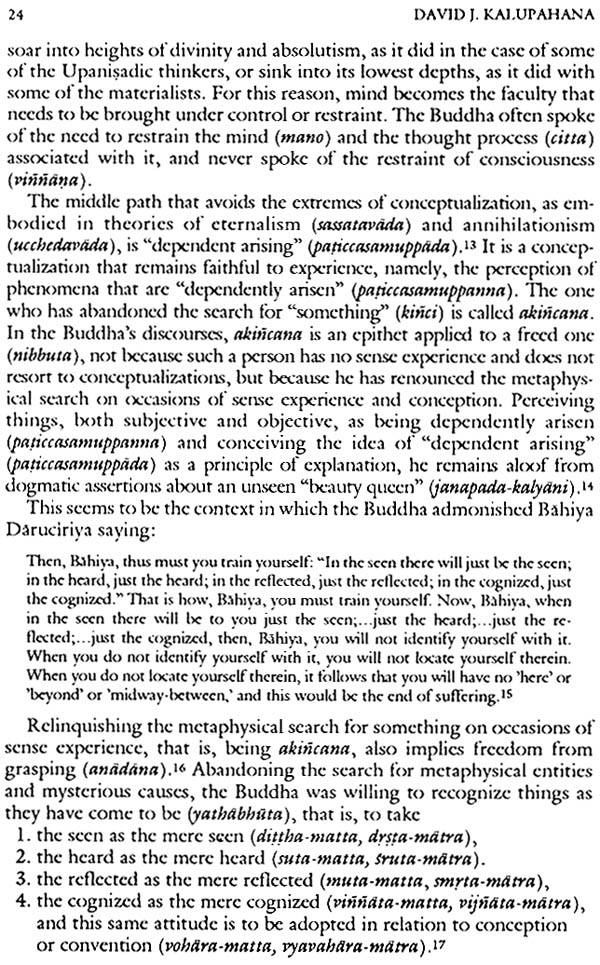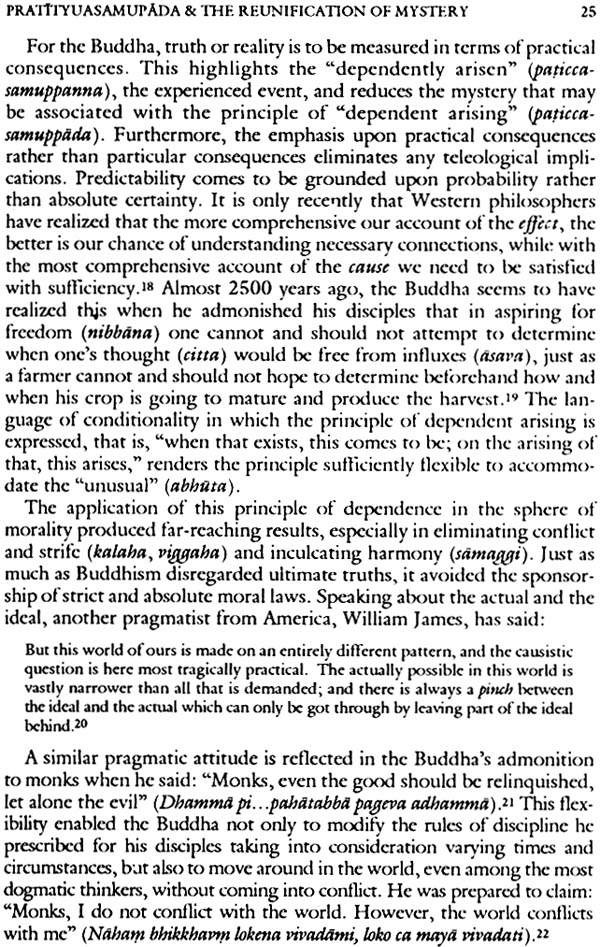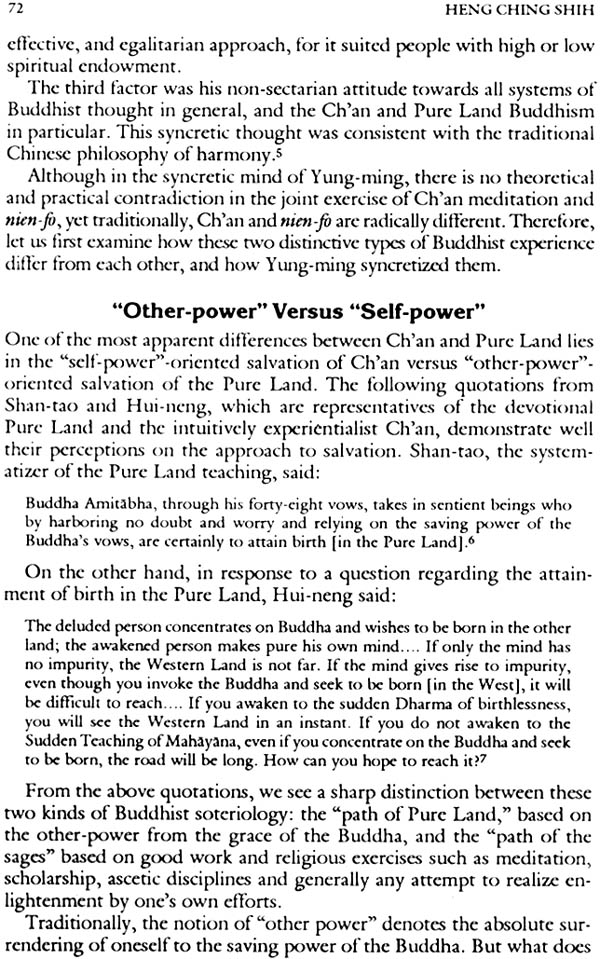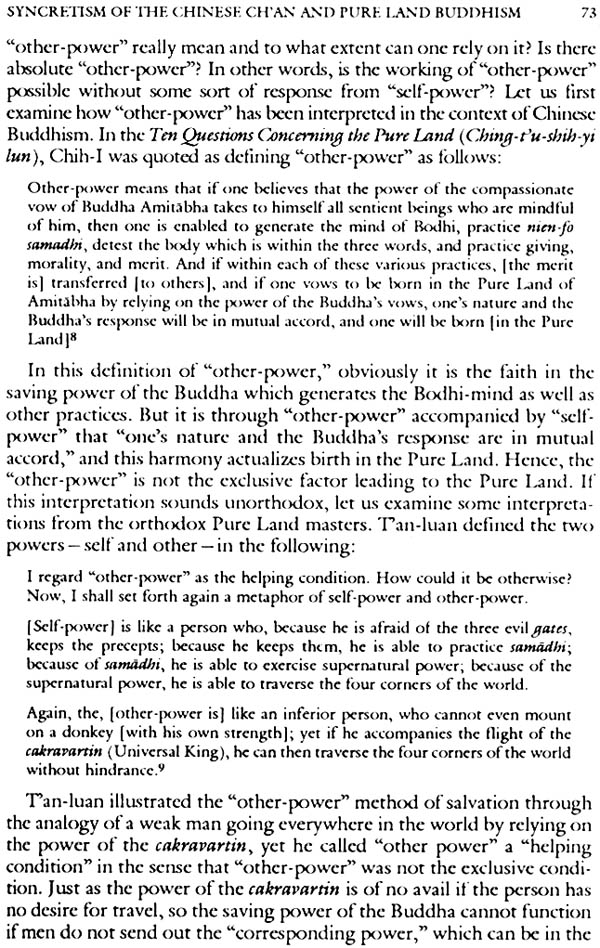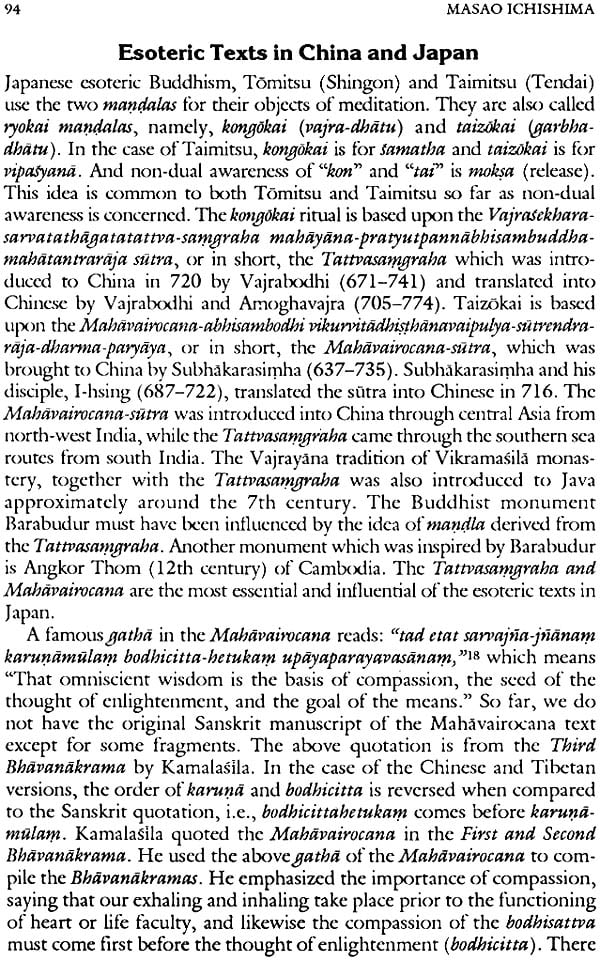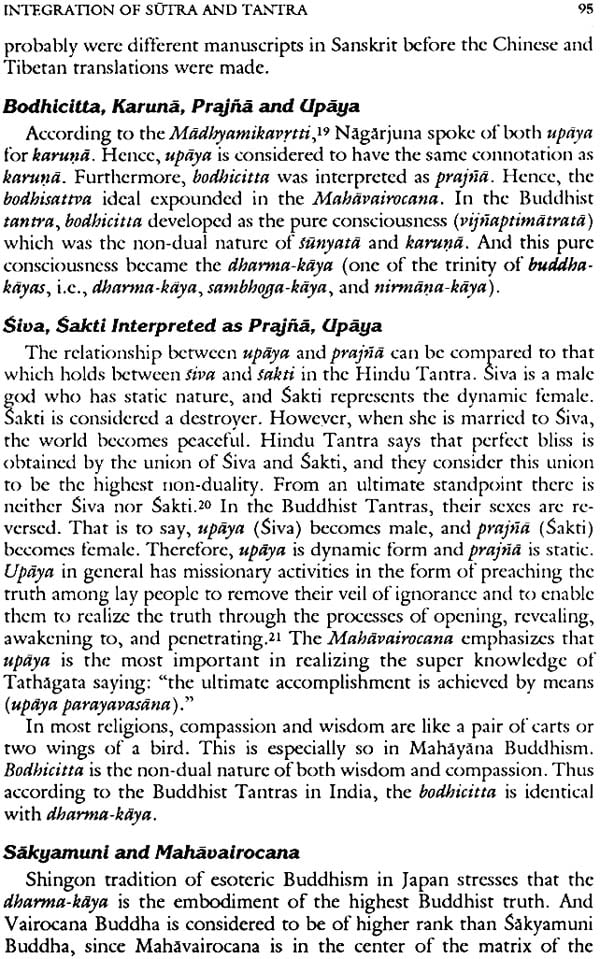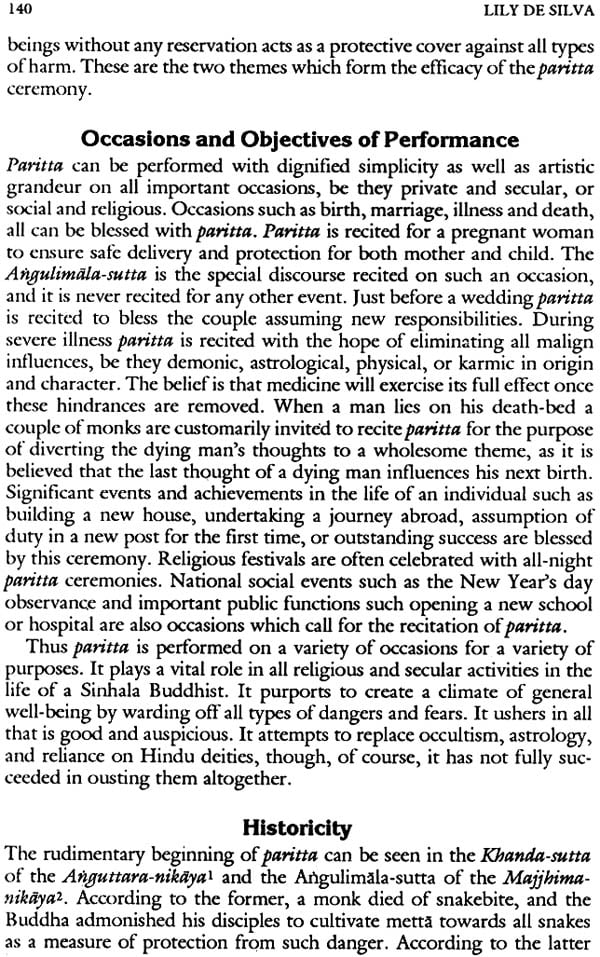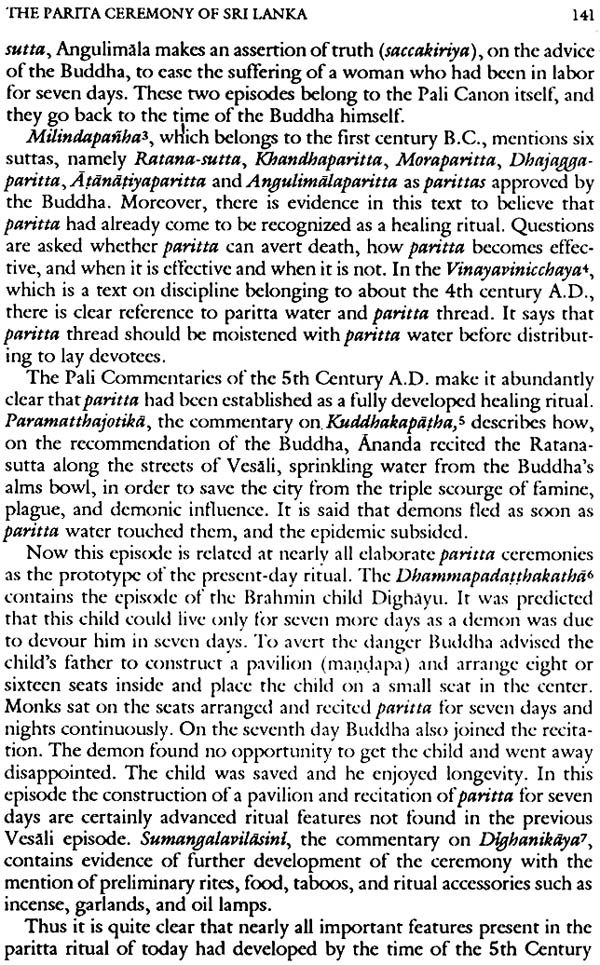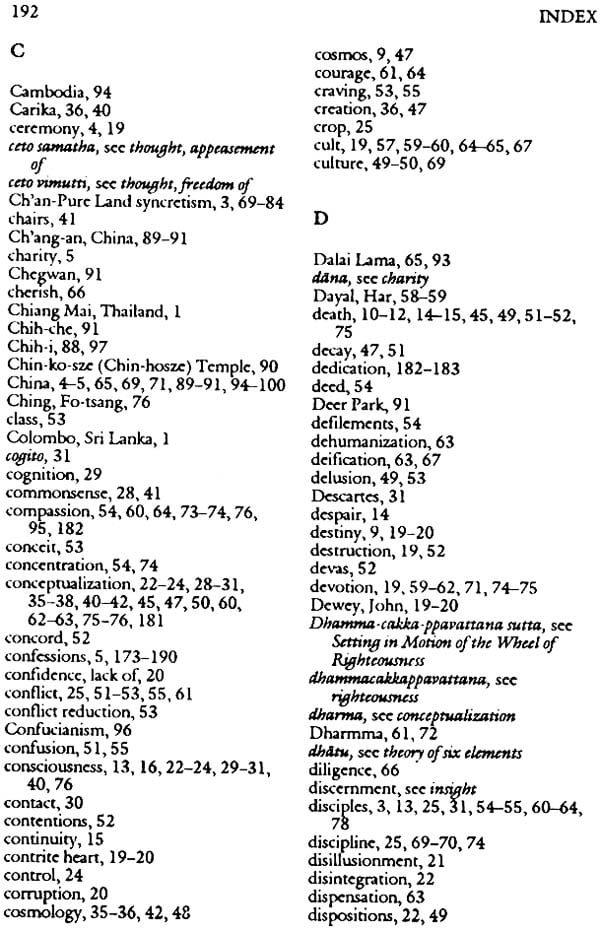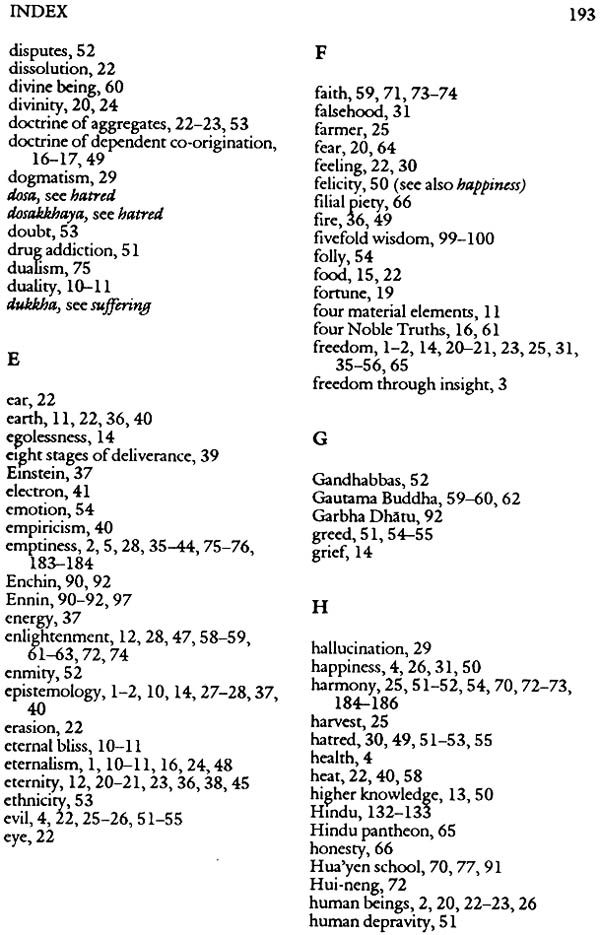
Buddhist Thought and Ritual
Book Specification
| Item Code: | IDD471 |
| Author: | David J. Kalupahana |
| Publisher: | Motilal Banarsidass Publishers Pvt. Ltd. |
| Language: | English |
| Edition: | 2001 |
| ISBN: | 9788120817739 |
| Pages: | 205 |
| Cover: | Paperback |
| Other Details | 8.5" X 5.5" |
| Weight | 280 gm |
Book Description
About the Book:
Buddhist Thought and Ritual will appeal to anyone interested in acquiring an authentic grasp of Buddhism as it lives and functions in today's world. The wide spectrum of Buddhist practice is represented here by the men and women who contributed to this volume. The focus on thought and ritual captures the organic interrelationship of these religious components and moves away from the compartmentalization characteristic of much religious scholarship. The reader discovers the central tenets of Buddhism, Anatta, Pratityasamutpada, Sunyatta, Nirvana, and others, not as free-floating curiosities, but in terms of their contemporary relevance and active participation in the formation of society and culture. Likewise, commonly practiced rituals such as the Paritta Ceremony and Mantra Recitation are analyzed in terms of their role in living Buddhism.
About the Author:
DAVID J. KALUPAHANA, PH. D., is one of the most famous writers of Buddhism in the English language. His previous books on Buddhism include Buddhist Philosophy and Culture, The Principles of Buddhist Psychology, The Path of Righteousness, and Buddhist Philosophy: A Historical Analysis. Dr. Kalupahana has written nine books, more than thirty articles, and contributed thirty-five minor articles and entries in the Encyclopedia of Buddhism.
The essays published here have been selected from a larger collection presented at three Buddhist intrareligious conferences held in Chiangmai, Thailand and in Colombo, Sri Lanka. These conferences were sponsored by the council for the world Religious. The two conferences held in Chiang mai deal with general philosophical and cultural themes relating to the various Buddhist traditions while the last one held in Colombo was on a more specific topic namely Religious Harmony through Rituals. The first eight the Colombo conference. The first part of the present volume therefore deals with facets of Buddhist thought both early and late while the second part examines some of the more significant rituals in the Buddhist tradition.
The essay on the Buddhist doctrine of Anatta by Y. Karunadasa the well known author of Buddhist Analysis of Matter (1967) is presented as the lead paper for obvious reasons Anatta as the author argues is the most radical of the Buddha’s doctrines for it sets Buddhism off from the two main currents of baffled many classical as well modern writers on Buddhism. When it was presented by the Buddha as a way of clearing the philosophical background containing two fossilized theories eternalism and nihilism and as a foundation of the middle path represented by the principle of dependent perceived it as a nihilistic doctrine Karunadasa;s paper provides a detailed treatment of this important doctrine indicating its epistemological ethical and social significance as well as its relevance to the Buddha’s conception of freedom.
My own paper that follows is on “Prathyasamutpada and the Renunciation of Mystery.” It deals with the positive conception of “dependent arising” as formulated by the Buddha, and as understood by some of the outstanding philosophers of the Buddhist tradition. The mystery that the Buddha intended to renounce is none other than the “sell” or “substance,” either in the subject or in the object, that is, the mysterious entity (anti) the negation of which is the theme of Karunadasa’s essay. For this reason, the analysis presented here complements that of Karunadasa. My analysis, however, is not confined to the first formulation of the doctrine by the Buddha. I have attempted to show that the Buddha’s statement of the doctrine is faithfully followed by the later disciples like Moggaliputta-tissa, Ngarjuna and Vasubandhu.
R.D. Gunaratne, a philosopher of science by training, examines the three concepts: space (akasa), emptiness (Sunyata), and freedom (nirvana) in Buddhism, and makes a bold attempt to interpret them in terms of the insights gained from the discoveries of modern science. Leaning toward the more absolutistic conception of space presented by the scientists, Gunaratne argues for similar absolutistic conceptions of space, emptiness, and freedom in the Buddhist context, yet without denying the relativism implied in the theory of dependent arising. This, however, is achieved on the basis of certain dichotomies such as the two truths: conventional or relative (sattwrti) and ultimate (paramartha), which indeed are susceptible to a variety of interpretations.
P.D. Premasiri, with his paper on “The Social Relevance of the Buddhist Nibbna Ideal,” joins camp with the authors of the first two papers against Gunaratne and argues not only in favor of the social relevance of the conception of freedom (nibbana), but also against any interpretation of it as an “absolute” or an “ultimate reality.” The major part of this essay is devoted to an analysis of a cliche, prominent among the early interpreters of Buddhism, that nibbana, the goal of Buddhism, is a transcendental reality beyond any conceptualization, and therefore the person who has attained this goal has nothing to do with the empirical world, hence with the social life of human beings. Utilizing the epistemological and psychological material in the early discourses of the Buddha, Premasiri defines nilthana as the psychological and moral transformation of a human being as a result of his adopting a right view or perspective regarding life in general, and human life in particular. He leaves no room for the introduction of any form of absolutism or transcendentalism.
Sanath Nanayakkara’s piece on “The Bodhisattva Ideal: Some Observations,” is a challenging one. Contrary to the widely accepted view that the Bodhisattva ideal is a Mahayana innovation, Nanayakkara argues persuasively that, in fact, it originated with Theravada, and that the earlier versions found in both Theravda and Mahyana represented a middle path between the two extreme forms of behavior: self-indulgence and self-mortification. It was a harmonious blend of self-interest and of the interests or welfare of others. That moderate ideal of bodhisattva, however, degenerated into an extremist view of absolute altruism in the hands of some of the later schools of Buddhism, both the Theravadin and Mahayanist. A closer examination of the subject matter of Nanayakkara’s paper will reveal that the controversy regarding the bodhisattva ideal is a reflection of the perennial philosophical problem relating to the conceptions of the “particular” and the “universal” and their application in moral discourse. The Buddha’s middle path was intended to avoid sharp dichotomies in theory as well as in practice.
Interestingly, a problem similar to the one discussed by Nanayakkara in relation to the conception of bodhisattva reappears in the contribution by Shih Heng-ching, one of the leading Buddhist scholars from the National Taiwan University. This time it is presented in the form of “self-power” versus “other-power.” It refers to the conflict between two Chinese Buddhist traditions—Ch’an, emphasizing “self-power,” and Pure Land, underscoring “other-power.” Her detailed treatment of the two traditions, as well as of the attempt by the later Chinese masters to syncretize Ch’an and Pure Land practices, clarifies for us the continued struggle by the later Buddhists to avoid extremes and to remain faithful to the middle path of the Buddha.
Yet another theme of integration of extremes is discussed in Masao Ichishima’s work on “Integration of Sutra and Tantra.” Appeasement of thought (ceto satnatha) or the freedom of thought (ceto vimutti) and freedom through insight (pannavimutti were complementary aspects of the freedom attained by the Buddha and his immediate disciples. Subsequent explanations tended to distinguish these two aspects as two entirely different means: appeasement (samatha) and insight or discernment (vipasyana), thereby generating absolute dichotomies that contributed to conflicts among various Buddhist schools. Ichishima’s paper deals with an attempt to integrate one such dichotomy, that is, the dichotomy between exoteric (satra) and esoteric (tanwa) forms of Buddhism by focusing upon the integration of the two aspects of freedom, namely, appeasement (samatha) and discernment (vipasyana).
The paper by Cheng-mei Ku, another prominent Buddhist scholar from Taiwan, on the “Mahisasaka View of Women,” may appear to be out of place among the themes discussed above. Considering the issue addressed in her paper and its current relevance, however, the editor deemed it appropriate for inclusion here, especially as a concluding statement on the problems relating to Buddhist thought. It clears up several misunderstandings regarding the way in which women were perceived in the Buddha’s teachings and proceeds to identify the particular schools that downgraded their status. The importance of her paper lies in its attempt to trace the several doctrines which, when put together, were ultimately responsible for the emergence of a low profile regarding women.
The second set of papers deals with some of the prominent rituals in the Buddhist countries, especially Sri Lanka and China. The first two papers are on the paritta (“protection”), a ceremony little known outside the Sri Lankan Buddhist tradition. They represent the impressions of two authors, a Buddhist monk who would be involved in the performance of the ceremony, and a laywoman who would be a participant. Venerable H. Saddhatissa, a well-known Theravada scholar-monk from England, provides an analysis of the text recited at thepaiitta ceremony, and on that basis explains the significance of sutra recitation as a ritual for “protection” (Paritta) of human life from evil forces. He argues that the sutra recitation has a psychological impact on the listeners and thus provides for health and happiness. As such, it is not very different from the mantra recitation of the Tibetan or East Asian Buddhists.
The second paper, “The Paritta Ceremony of Sri Lanka: Its Antiquity and Symbolism,” is by Lily de Silva, the editor of the monumental three-volume text of the Dhanikaya-aqahakatha-.tika. It presents a history of theparitta ceremony and, more importantly, a detailed analysis of its symbolism. The paper is an excellent summary of the research she has conducted on the subject for several years. It is difficult to make sense of any ritual unless we are able to understand the symbolism involved. De Silva makes a valuable contribution by indicating the symbolic significance of each and every object utilized in the ceremony and relating them in such a way that renders the whole ceremony meaningful in a Buddhist context. (A paper on the Tibetan mantra recitation would have been an interesting companion for the two papers on the paritta ceremony, providing for a comparative study of the meaning and relevance of sutra-recitation in the different Buddhist traditions. Unfortunately, the Tibetan representative was unable to participate at the conference devoted to rituals.)
The next essay, by Premasiri, is on the “Significance of the Ritual Concerning Offerings to Ancestors in Theravada Buddhism.” The author traces the history of this very ancient practice in the Vedas and Brahmanical literature of the period before the rise of Buddhism, but endeavors to distinguish the Buddhist version from the Brahmanical by highlighting the moral and psychological character of the former. (Even though the essay is specifically on the ritual as practiced in a Theravada country like Sri Lanka considering the enormous popularity of the ritual in China and Japan at least a brief reference to the nature of the ritual as practiced in those countries would have given a more complete portrayal of the subject matter).
The ritual of self sacrifice or self immolation is one that can hardly be justified in a Buddhist context especially in light of the very first discourse of the Buddha the establishment of the principle of righteousness where he condemned both self indulgence and self mortification. Even though self sacrifice came to be looked upon as a noble ideal both in Theravada and in Mahayana at a later period actual suicide as a religious ritual is extremely rare in the South Asian Buddhist tradition. Chen-mei ku’s second essay included in this volume. A ritual of the Mahayan self sacrifice explains how the conception of offering or charity when combined with the Mahayana evaluation of the physical human personality as a created body can contribute to the ritual of self sacrifice. Hence its popularity in the east Asian Buddhist countries.
The final essay on Chinese Buddhist Confessional Rituals their origin and spiritual Significance is by Hsiang chou yo of the Chinese culture University in the Chinese Buddhist monastic life. His manner of relating the Mahayana conception of emptiness to the confessional ritual will be of absorbing interest to those who have difficulty in harmonizing speculative metaphysics and down to earth rituasl.
The essays included in this volume provide for the reader the diverse and various facets of Buddhist thought and rituals. Not only does the work facilitate an understanding of the nature of Buddhist theory and practice but Furhtermore reveals the continuity in such theory and practice as Buddhism spread throughout the length and breadth of the vast continent of Asia.
| List of Abbreviation | vii | |
| Introduction (David J. Kalupahana) | 1 | |
| | ||
| 1 | The Buddhist Doctrine of Anatta (T. Karunadasa) | 9 |
| 2 | Pratiyasmupada and the Renunciation of Mystery (David J. Kalapahana) | 19 |
| 3 | Space Emptiness and Freedom (R.D. Gunaratne) | 35 |
| 4 | The social relevance of the Buddhist Nibbana Ideal (P.D. Premasiri) | 45 |
| 5 | The Bodhisattva Ideal Some Observations (Samath Nanayakkara) | 57 |
| 6 | The Syncertism of Chinese Ch’an and pure land Buddhism (Heng ching Shih) | 69 |
| | ||
| 7 | Integration of sutra and Tantra (Masao Ichishima) | 87 |
| 8 | The Mahisaka view of women (Cheng mei ku) | 103 |
| 9 | The Significance of Paritta and its application in the Theravada tradition (Hammalawa Saddhatissa) | 125 |
| 10 | The Paritta Ceremony of Sri Lanka its Antiquity and Symbolism (Lily de Silva) | 139 |
| 11 | Significance of the Ritual concerning offerings to ancestors in Theraveda Buddhism (P.D. Premasiri) | 151 |
| 12 | A Ritual of Mahayana Vinaya Self Sacrifice (Chang Mei Ku) | 159 |
| 13 | Chinese Buddhist Confessional Rituals their origin and Spiritual implications (Hsiang chou to) | 173 |
| List of Contributors | 189 | |
| Index | 191 |
